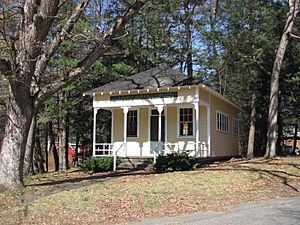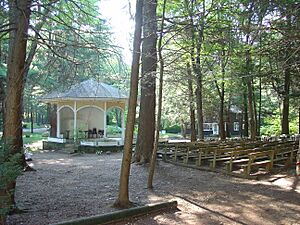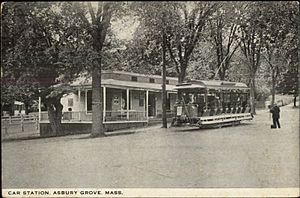Asbury Grove facts for kids
Asbury Grove is a special place in Hamilton, Massachusetts. It started in 1857 as a camp meeting site. This was a popular religious movement in the mid-1800s. The Methodist church founded the camp. They bought 75 acres of land for it. Part of the land included a farmhouse. This farmhouse later became the Superintendent's Cottage.
Methodist groups from nearby towns used the camp in the summer. Towns like Lynn, Groveland, and Reading came here. The camp was named after Bishop Francis Asbury. He was an important leader in the Methodist camp meeting movement. In 2009, Asbury Grove was added to the National Register of Historic Places. It is now known as the Asbury Grove Historic District.
Contents
What are Camp Meetings?
Camp meetings were big religious gatherings. They started around 1800 in Kentucky. This movement then spread across the United States. These meetings usually lasted several days. People would gather for intense church services. They also spent time praying and studying the Bible.
Asbury Grove is a Methodist community. But other groups, like Presbyterians and Baptists, also held camp meetings. Asbury Grove wasn't the first camp in Massachusetts. Others were on Cape Cod and Wesleyan Grove on Martha's Vineyard. However, Asbury Grove was special. It was made so 24 Methodist churches could easily attend revival meetings.
The Early Days of Asbury Grove
The very first meeting at Asbury Grove was in August 1859. About 2,000 people came at the start. Some reports say nearly 12,000 people attended by the end of that first week. These camp meetings were huge events. They could make a town's population double or even triple!
Reverend Gorham suggested that camp life should be simple. So, early camps had mostly cloth tents. People paid a small fee to rent a tent spot. They also had wooden stands for preaching. Gorham also encouraged "society tents." These were smaller tents where groups could meet. They would hold Bible studies and prayer meetings there.
The main preaching spot at Asbury Grove was called The Circle. It was surrounded by 36 large tents. Each tent belonged to one of the member churches. These big tents had six-foot-high wooden walls. They had canvas roofs. The ground inside was often covered with straw.
Growing Bigger: The Peak Years
The camp meeting movement became very popular in the late 1800s. The years from 1870 to 1879 were a time of great growth for Asbury Grove. During this period, over 200 cottages were built. This was a big change from the early days of simple tents. The oldest cottages were built closest to The Circle. Newer buildings spread out from there.
Like other camps, Asbury Grove slowly added permanent buildings. These included a dining hall, a bakery, and a post office. There was even a railroad ticket office. By 1875, the society tents were replaced. They became two-story wooden buildings. Five of these buildings are still standing today.
People from all walks of life came to the camp. A list from the late 1800s shows many different jobs. There were shoe makers, teamsters, and carpenters. This mix of people was part of the camp's idea. Camp meetings were meant to be a break from everyday life. People focused on their faith, not on their wealth.
A typical day at Asbury Grove started early. Wake-up was at 5:30 a.m. Breakfast was at 6:30 a.m. Preaching services were at 10:00 a.m., 3:00 p.m., and 7:00 p.m. Lunch was at noon, and dinner was at 5:00 p.m. Each group also had a prayer meeting after each meal. Curfew was at 10:00 p.m. A policeman, and later a camp member, made sure everyone was in their cottages.
Rules also covered personal activities. No vehicles were allowed during preaching services. Smoking was not allowed in The Circle. Alcohol was strongly discouraged, even in private cottages.
When Things Changed
By the late 1800s, camp meetings became less popular. This was partly because society was changing. Also, travel became easier with railroads and cars. A big fire in 1927 caused a lot of damage to the camp. Many cottages were harmed or destroyed.
Other fires and bad weather in the early 1900s also damaged the camp. Some damaged buildings were rebuilt. But others were left empty or fell apart.
The Asbury Camp Meeting Association started adding more fun activities. Methodist preaching was still important. But they added programs for kids and teens. There were Bible conferences and patriotic rallies. They also offered sports like baseball and tennis.
Asbury Grove Today
Asbury Grove is still active today. It covers 83 acres of forest. The layout is much like the original design. Historians believe the circular plan was very popular for camps back then. The Methodist church owns the land. But many cottages are private homes. About 100 of the 153 remaining cottages still look like their original design.
Around 30 homes are modern or have been changed a lot. Most cottages are still used for summer visits. But 60 of them have been made ready for year-round living.
In 2009, Asbury Grove celebrated its 150th anniversary. The camp association fixed up many common buildings. This included the tabernacle, kitchen, and dining hall. The camp also hosted many events for the anniversary. These included worship services, social gatherings, and cottage tours. There were also theater shows and sports events.
See Also





